Structure and Composition of Micro-Manganese Nodules in Deep-Sea Carbonate from the Zhaoshu Plateau, North of the South China Sea
Abstract
:1. Introduction
2. Geological Setting
3. Materials and Methods
3.1. Dives and Sampling
3.2. Laboratory Analyses
3.2.1. Petrography and Mineralogical Studies
3.2.2. Scanning Electron Microscopy and Element Mapping
3.2.3. Bulk Geochemical Analysis
3.2.4. In Situ Geochemical Analysis by EPMA
4. Results
4.1. Sea Floor Observation and Carbonates Distribution
4.2. Description of Carbonates and Samples
4.3. Micro-Manganese Nodules in Carbonates: Morphology, Sizes, and Mineralogical Properties
4.3.1. Textures of the Micro-Manganese Nodules
4.3.2. Mineralogy of the Micro-Manganese Nodules
4.4. Geochemistry
5. Discussion
5.1. Carbonates at the Bottom of the Zhaoshu Plateau
5.2. Formation of Micro-Manganese Nodules within the Carbonate Matrix
6. Conclusions
- (1)
- Near-sea-floor observations along the southeast slope of the Zhaoshu plateau characterized the sea floor as having an evident seabed configuration, in which three significant features were noted: reef-carbonates, pelagic sediments, and outcrop of volcanic rocks. The geomorphologies indicate intense subsidence and emersion accompanied by sea-level fall of the plateau.
- (2)
- The main facies of carbonate rocks collected at −1170 m include skeletal grains of algae and foraminifers embedded in a calcite muddy matrix. Micritization is the main diagenetic feature with calcite micrites around bioclasts or partially micritized biological grains.
- (3)
- Micro-manganese nodules widely developed both at the outer and inner of carbonate rocks but on the micro-scale. The botryoidal pattern of laminated oxides more likely developed at the rock surface. Concentric and sub-spherical shapes formed in the rock with high probability.
- (4)
- The micro-nodules are mainly composed of 7 and 10 Å vernadite and todorokite, both of which are closely related to carbonate micrite. They were found to have high Mn/Fe ratios and to be enriched in Ni + Cu with low Co contents.
- (5)
- These micro-nodules are a mixed type with early diagenetic growth under oxic–suboxic conditions. The collapse of the carbonate framework and micritization led to the redistribution of manganite. The reduction of manganite occurred in the inner of carbonate, probably associated with Mn-reducing heterotrophic microorganisms, and then transformed into todorokite in processes similar to those described in buried nodules in sediments.
Supplementary Materials
Author Contributions
Funding
Acknowledgments
Conflicts of Interest
References
- Hein, J.R.; Koschinsky, A. Deep-ocean ferromanganese crusts and nodules. In Treatise on Geochemistry, 2nd ed.; Holland, H.D., Turekian, K.K., Eds.; Elsevier: Oxford, UK, 2014; pp. 273–291. [Google Scholar]
- Halbach, F.; Stackelberg, V. The Manganese nodule belt of the Pacific Ocean. Mineral. Mag. 1988, 53, 664. [Google Scholar]
- Roy, S. Environments and processes of manganese deposition. Econ. Geol. Bull. Soc. Econ. Geol. 1992, 87, 1218–1236. [Google Scholar] [CrossRef]
- Conrad, T.; Hein, J.R.; Paytan, A.; Clague, D.A. Formation of Fe-Mn crusts within a continental margin environment. Ore Geol. Rev. 2017, 87, 25–40. [Google Scholar] [CrossRef]
- Heller, C.; Kuhn, T.; Versteegh, G.J.M.; Wegorzewski, A.V.; Kasten, S. The geochemical behavior of metals during early diagenetic alteration of buried manganese nodules. Deep Sea Res. Part I Oceanogr. Res. Pap. 2018, 142, 16–33. [Google Scholar] [CrossRef]
- Johnson, J.E.; Webb, S.M.; Ma, C.; Fischer, W.W. Manganese mineralogy and diagenesis in the sedimentary rock record. Geochim. Cosmochim. Acta 2016, 173, 210–231. [Google Scholar] [CrossRef] [Green Version]
- Takahashi, Y.; Manceau, A.; Geoffroy, N.; Marcus, M.A.; Usui, A. Chemical and structural control of the partitioning of Co, Ce, and Pb in marine ferromanganese oxides. Geochim. Cosmochim. Acta 2007, 71, 984–1008. [Google Scholar] [CrossRef] [Green Version]
- Uspenskaya, T.Y.; Gorshkov, A.I.; Sivtsov, A.V. Mineralogy and internal structure of Fe-Mn nodules from the Clarion-Clipperton Zone. Int. Geol. Rev. 1987, 29, 363–371. [Google Scholar] [CrossRef]
- LugoviĆ, B.; Segvic, B.; Šegvić, T. Mn-crust todorokite mineralization on SW backshore Cretaceous limestones from the island of Dugi Otok (Central Adriatic, Croatia). Acta Adriat. 2008, 49, 53–63. [Google Scholar]
- Rojkovič, I.; Aubrecht, R.; Mišík, M. Mineral and chemical composition of manganese hardgrounds in Jurassic limestones of the Western Carpathians. Geol. Carpathica 2003, 54, 317–328. [Google Scholar]
- Marino, E.; Gonzalez, F.J.; Kuhn, T.; Madureira, P.; Wegorzewski, A.V.; Mirao, J.; Medialdea, T.; Oeser, M.; Miguel, C.; Reyes, J.; et al. Hydrogenetic, diagenetic and hydrothermal processes forming ferromanganese crusts in the Canary Island Seamounts and their influence in the metal recovery rate with hydrometallurgical methods. Minerals 2019, 9, 439. [Google Scholar] [CrossRef] [Green Version]
- Koschinsky, A.; Halbach, P. Sequential leaching of marine ferromanganese precipitates: Genetic implications. Geochim. Cosmochim. Acta 1995, 59, 5113–5132. [Google Scholar] [CrossRef]
- Wegorzewski, A.; Kuhn, T.; Dohrmann, R.; Wirth, R.; Grangeon, S. Mineralogical characterization of individual growth structures of Mn-nodules with different Ni+Cu content from the central Pacific Ocean. Am. Mineral. 2015, 100, 2497–2508. [Google Scholar] [CrossRef]
- Christ, N.; Immenhauser, A.; Wood, R.A.; Darwich, K.; Niedermayr, A. Petrography and environmental controls on the formation of Phanerozoic marine carbonate hardgrounds. Earth-Sci. Rev. 2015, 151, 176–226. [Google Scholar] [CrossRef]
- Conti, M.A.; Girasoli, D.E.; Frezza, V.; Conte, A.M.; Martorelli, E.; Matteucci, R.; Chiocci, F.L. Repeated events of hardground formation and colonisation by endo-epilithozoans on the sediment-starved Pontine continental slope (Tyrrhenian Sea, Italy). Mar. Geol. 2013, 336, 184–197. [Google Scholar] [CrossRef]
- Wheeler, A.J.; Stadnitskaia, A. Benthic Deep-Sea Carbonates: Reefs and Seeps. In Developments in Sedimentology; HüNeke, H., Mulder, T., Eds.; Elsevier: Amsterdam, The Netherlands, 2011; pp. 397–455. [Google Scholar]
- Noé, S.; Titschack, J.; Freiwald, A.; Dullo, W.-C. From sediment to rock: Diagenetic processes of hardground formation in deep-water carbonate mounds of the NE Atlantic. Facies 2006, 52, 183–208. [Google Scholar] [CrossRef] [Green Version]
- Aghib, F.S.; Bernoulli, D.; Weissert, H. Hardground formation in the Bannock Basin, Eastern Mediterranean. Mar. Geol. 1991, 100, 103–113. [Google Scholar] [CrossRef]
- Xu, H.; Peng, X.; Chen, S.; Li, J.; Dasgupta, S.; Ta, K.; Du, M. Macrofaunal burrowing enhances deep-sea carbonate lithification on the Southwest Indian Ridge. Biogeosciences 2018, 15, 6387–6397. [Google Scholar] [CrossRef]
- Guptha, M.V.S.; Banerjee, R.; Mergulhao, L. On the nature of the calcareous substrate of a ferromanganese crust from the Vityaz Fracture Zone, Central Indian Ridge: Inferences on paleoceanography. Geo-Marine Lett. 2002, 22, 12–18. [Google Scholar]
- Yu, J.; Anderson, R.F.; Rohling, E.J. Deep ocean carbonate chemistry and glacial-interglacial atmospheric CO2 changes. Oceanography 2014, 27, 16–25. [Google Scholar] [CrossRef] [Green Version]
- Schlager, W. Carbonate sedimentology and sequence stratigraphy. In SEPM Concepts in Sedimentology and Paleontology; Society for Sedimentary Geology (SEPM): Tulsa, Ok, USA, 2005. [Google Scholar]
- Ridgwell, A.; Zeebe, R.E. The role of the global carbonate cycle in the regulation and evolution of the Earth system. Earth Planet. Sci. Lett. 2005, 234, 299–315. [Google Scholar] [CrossRef]
- Croizé, D.; Renard, F.; Gratier, J.-P. Compaction and porosity reduction in carbonates: A review of observations, theory, and experiments. Adv. Geophys. 2013, 54, 181–238. [Google Scholar]
- Rae, J.W.B.; Foster, G.L.; Schmidt, D.N.; Elliott, T. Boron isotopes and B/Ca in benthic foraminifera: Proxies for the deep ocean carbonate system. Earth Planet. Sci. Lett. 2011, 302, 403–413. [Google Scholar] [CrossRef]
- Holligan, P.M.; Robertson, J.E. Significance of ocean carbonate budgets for the global carbon cycle. Glob. Chang. Biol. 1996, 2, 85–95. [Google Scholar] [CrossRef]
- Reolid, M. Palaeoenvironmental contexts for microbial communities from Fe-Mn crusts of Middle-Upper Jurassic hardgrounds (Betic-Rifian Cordillera). Rev. Esp. Paleontol. 2011, 26, 135–160. [Google Scholar] [CrossRef]
- Halbach, P.; Puteanus, D. The influence of the carbonate dissolution rate on the growth and composition of Co-rich ferromanganese crusts from Central Pacific Seamount Areas. Earth Planet. Sci. Lett. 1984, 68, 73–87. [Google Scholar] [CrossRef]
- Berner, R.A.; Westrich, J.T.; Graber, R.; Smith, J.; Martens, C.S. Inhibition of aragonite precipitation from supersaturated seawater; a laboratory and field study. Am. J. Sci. 1978, 278, 816–837. [Google Scholar] [CrossRef]
- Konhauser, K.O. Diversity of bacterial iron mineralization. Earth-Sci. Rev. 1998, 43, 91–121. [Google Scholar] [CrossRef]
- Taylor, B.; Hayes, D.E. The Tectonic Evolution of the South China Basin. In The Tectonic and Geologic Evolution of Southeast Asian Seas and Islands; Hayes, D.E., Ed.; American Geophysical Union: Washington, DC, USA, 1980; pp. 89–104. [Google Scholar]
- Ru, K.; Pigott, J.D. Episodic rifting and subsidence in the South China Sea. AAPG Bull. 1986, 70, 1136–1155. [Google Scholar]
- Wu, S.; Yang, Z.; Wang, D.; Lü, F.; Lüdmann, T.; Fulthorpe, C.; Wang, B. Architecture, development and geological control of the Xisha carbonate platforms, northwestern South China Sea. Mar. Geol. 2014, 350, 71–83. [Google Scholar] [CrossRef]
- Shen, J.; Wang, Y. Modern microbialites and their environmental significance, Meiji reef atoll, Nansha (Spratly) Islands, South China Sea. Sci. China Ser. D Earth Sci. 2008, 51, 608–617. [Google Scholar] [CrossRef] [Green Version]
- Zhong, Y.; Liu, Q.; Chen, Z.; González, F.J.; Hein, J.R.; Zhang, J.; Zhong, L. Tectonic and paleoceanographic conditions during the formation of ferromanganese nodules from the northern South China Sea based on the high-resolution geochemistry, mineralogy and isotopes. Mar. Geol. 2019, 410, 146–163. [Google Scholar] [CrossRef]
- Jiang, X.; Sun, X.; Guan, Y. Biogenic mineralization in the ferromanganese nodules and crusts from the South China Sea. J. Asian Earth Sci. 2019, 171, 46–59. [Google Scholar] [CrossRef]
- Zhong, Y.; Chen, Z.; González, F.J.; Hein, J.R.; Zheng, X.; Li, G.; Luo, Y.; Mo, A.; Tian, Y.; Wang, S. Composition and genesis of ferromanganese deposits from the northern South China Sea. J. Asian Earth Sci. 2017, 138, 110–128. [Google Scholar] [CrossRef] [Green Version]
- Gao, J.; Bangs, N.; Wu, S.; Cai, G.; Han, S.; Ma, B.; Wang, J.; Yangbing, X.; Huang, W.; Dong, D.; et al. Post-seafloor spreading magmatism and associated magmatic hydrothermal systems in the Xisha uplift region, northwestern South China Sea. Basin Res. 2019, 31, 688–708. [Google Scholar] [CrossRef]
- Shao, L.; Li, Q.; Zhu, W.; Zhang, D.; Qiao, P.; Liu, X.; You, L.; Cui, Y.; Dong, X. Neogene carbonate platform development in the NW South China Sea: Litho-, bio- and chemo-stratigraphic evidence. Mar. Geol. 2017, 385, 233–243. [Google Scholar] [CrossRef] [Green Version]
- Zhu, W.; Xie, X.; Wang, Z.; Zhang, D.; Zhang, C.; Cao, L.; Shao, L. New insights on the origin of the basement of the Xisha Uplift, South China Sea. Sci. China Earth Sci. 2017, 60, 2214–2222. [Google Scholar] [CrossRef]
- Yu, K. Coral reefs in the South China Sea: Their response to and records on past environmental changes. Sci. China Earth Sci. 2012, 55, 1217–1229. [Google Scholar] [CrossRef]
- Hutchison, C.S. Marginal basin evolution: The southern South China Sea. Mar. Pet. Geol. 2004, 21, 1129–1148. [Google Scholar] [CrossRef]
- Wegorzewski, A.V.; Grangeon, S.; Webb, S.M.; Heller, C.; Kuhn, T. Mineralogical transformations in polymetallic nodules and the change of Ni, Cu and Co crystal-chemistry upon burial in sediments. Geochim. Cosmochim. Acta 2020, 282, 19–37. [Google Scholar] [CrossRef]
- Flood, P. Development of northwest Pacific guyots: General results from Ocean Drilling Program legs 143 and 144. Isl. Arc 1999, 8, 92–98. [Google Scholar] [CrossRef]
- Wegorzewski, A.V.; Kuhn, T. The influence of suboxic diagenesis on the formation of manganese nodules in the Clarion Clipperton nodule belt of the Pacific Ocean. Mar. Geol. 2014, 357, 123–138. [Google Scholar] [CrossRef]
- Manceau, A.; Lanson, M.; Takahashi, Y. Mineralogy and crystal chemistry of Mn, Fe, Co, Ni, and Cu in a deep-sea Pacific polymetallic nodule. Am. Mineral. 2014, 99, 2068–2083. [Google Scholar] [CrossRef]
- Peacock, C.L.; Sherman, D.M. Sorption of Ni by birnessite: Equilibrium controls on Ni in seawater. Chem. Geol. 2007, 238, 94–106. [Google Scholar] [CrossRef]
- Ostrooumov, M. Raman and Infrared Reflection Spectroscopic Study of Mineralogical Composition of Iron-Manganese Nodules (Pacific and Indian Oceans). Int. J. Exp. Spectrosc. Tech. 2017, 2, 2–12. [Google Scholar] [CrossRef] [Green Version]
- Ma, Z.; Zhu, Y.; Liu, X.; Luo, W.; Ma, R.; Xu, S. Quaternary calcareous alga and its ecological function from the ZK-1 well in Xisha Islands. Earth Sci.-J. China Univ. Geosci. 2015, 40, 718–724, (In Chinese with English abstract). [Google Scholar]
- Luo, W.; Zhang, D.; Liu, X.; Wang, Z.; Hu, W.; Wang, Y. A comprehensive stratigraphic study of well XK-1 in the Xiasha area. J. Stratigr. 2018, 42, 485–498, (In Chinese with English abstract). [Google Scholar]
- Sallam, E.S.; Afife, M.M.; Fares, M.; van Loon, A.J.; Ruban, D.A. Sedimentary facies and diagenesis of the Lower Miocene Rudeis Formation (southwestern offshore margin of the Gulf of Suez, Egypt) and implications for its reservoir quality. Mar. Geol. 2019, 413, 48–70. [Google Scholar] [CrossRef]
- Francini-Filho, R.B.; Asp, N.E.; Eduardo, S.; John, H.; Kenneth, L.; Nilo, D.A.; Vasconcelos, A.A.; Ricardo, B.; Rezende, C.E.; Omachi, C.Y. Perspectives on the Great Amazon Reef: Extension, biodiversity, and threats. Front. Mar. Sci. 2018, 5, 142. [Google Scholar] [CrossRef]
- Ries, J.B. Mg fractionation in crustose coralline algae: Geochemical, biological, and sedimentological implications of secular variation in the Mg/Ca ratio of seawater. Geochim. Cosmochim. Acta 2006, 70, 891–900. [Google Scholar] [CrossRef]
- Li, Y.; Yu, K.; Wang, Y.; Wang, R.; Fan, T.; Bian, L. The composition of coralline algae from well Chenke-2 Xisha Islands South China Sea and its implication on the water depth. Acta Micropalaeontol. Sin. 2017, 34, 268–278, (In Chinese with English abstract). [Google Scholar]
- Moore, C.H.; Wade, W.J. Carbonate diagenesis: Introduction and tools. In Developments in Sedimentology; Moore, C.H., Wade, W.J., Eds.; Elsevier: Amsterdam, The Netherlands, 2013; pp. 67–89. [Google Scholar]
- Flügel, E. Diagenesis, porosity, and dolomitization. In Microfacies of Carbonate Rocks; Springer: Berlin/Heidelberg, Germany, 2004; pp. 267–338. [Google Scholar]
- Moore, C.H. Carbonate Diagenesis and Porosity; Elsevier: Amsterdam, The Netherlands, 1989. [Google Scholar]
- Wanless, H.R. Burial diagenesis in limestones. In Sediment Diagenesis; Parker, A., Sellwood, B.W., Eds.; Springer: Dordrecht, The Netherlands, 1983; pp. 379–417. [Google Scholar]
- Cook, H.E.; Egbert, R.M. Diagenesis of deep-sea carbonates. In Developments in Sedimentology; Larsen, G., Chilingar, G.V., Eds.; Elsevier: Amsterdam, The Netherlands, 1979; pp. 213–288. [Google Scholar]
- Vodrazkova, S.; Munnecke, A. Calcispheres as a source of lime mud and peloids evidence from the early Middle Devonian of the Prague Basin, the Czech Republic. Bull. Geosci. 2010, 85, 585–602. [Google Scholar]
- Gischler, E.; Dietrich, S.; Harris, D.; Webster, J.M.; Ginsburg, R.N. A comparative study of modern carbonate mud in reefs and carbonate platforms: Mostly biogenic, some precipitated. Sediment. Geol. 2013, 292, 36–55. [Google Scholar] [CrossRef]
- Enríquez, S.; Schubert, N. Direct contribution of the seagrass Thalassia testudinum to lime mud production. Nat. Commun. 2014, 5, 3835. [Google Scholar] [CrossRef] [Green Version]
- Fu, Y.; Wen, H. Variabilities and enrichment mechanisms of the dispersed elements in marine Fe–Mn deposits from the Pacific Ocean. Ore Geol. Rev. 2020, 121, 103470. [Google Scholar] [CrossRef]
- Guan, Y.; Sun, X.; Jiang, X.; Sa, R.; Zhou, L.; Huang, Y.; Liu, Y.; Li, X.; Lu, R.; Wang, C. The effect of Fe-Mn minerals and seawater interface and enrichment mechanism of ore-forming elements of polymetallic crusts and nodules from the South China Sea. Acta Oceanol. Sin. 2017, 36, 34–46. [Google Scholar] [CrossRef]
- Hein, J.R.; Schulz, M.S.; Dunham, R.E.; Stern, R.J.; Bloomer, S.H. Diffuse flow hydrothermal manganese mineralization along the active Mariana and southern Izu-Bonin arc system, western Pacific. J. Geophys. Res. Solid Earth 2008, 113, B08S14. [Google Scholar] [CrossRef] [Green Version]
- Gonzalez, F.J.; Somoza, L.; Hein, J.R.; Medialdea, T.; Leon, R.; Urgorri, V.; Reyes, J.; Martin-Rubi, J.A. Phosphorites, Co-rich Mn nodules, and Fe-Mn crusts from Galicia Bank, NE Atlantic: Reflections of Cenozoic tectonics and paleoceanography. Geochem. Geophys. Geosyst. 2016, 17, 346–374. [Google Scholar] [CrossRef] [Green Version]
- Bodeï, S.; Manceau, A.; Geoffroy, N.; Baronnet, A.; Buatier, M. Formation of todorokite from vernadite in Ni-rich hemipelagic sediments. Geochim. Cosmochim. Acta 2007, 71, 5698–5716. [Google Scholar] [CrossRef]
- Li, L.; Qu, T. Thermohaline circulation in the deep South China Sea basin inferred from oxygen distributions. J. Geophys. Res. Ocean. 2006, 111, C05017. [Google Scholar] [CrossRef]
- Wang, X.-H.; Schloßmacher, U.; Natalio, F.; Schröder, H.C.; Wolf, S.E.; Tremel, W.; Müller, W.E.G. Evidence for biogenic processes during formation of ferromanganese crusts from the Pacific Ocean: Implications of biologically induced mineralization. Micron 2009, 40, 526–535. [Google Scholar] [CrossRef]
- Chaput, D.L.; Fowler, A.J.; Seo, O.; Duhn, K.; Hansel, C.M.; Santelli, C.M. Mn oxide formation by phototrophs: Spatial and temporal patterns, with evidence of an enzymatic superoxide-mediated pathway. Sci. Rep. 2019, 9, 18244. [Google Scholar] [CrossRef] [PubMed]
- Knauer, K.; Jabusch, T.; Sigg, L. Manganese uptake and Mn(II) oxidation by the alga Scenedesmus subspicatus. Aquat. Sci. 1999, 61, 44–58. [Google Scholar] [CrossRef] [Green Version]
- Schöler, A.; Zaharieva, I.; Zimmermann, S.; Wiechen, M.; Manke, A.-M.; Kurz, P.; Plieth, C.; Dau, H. Biogenic manganese–calcium oxides on the cell walls of the algae Chara Corallina: Elemental composition, atomic structure, and water-oxidation catalysis. Eur. J. Inorg. Chem. 2014, 2014, 780–790. [Google Scholar] [CrossRef]
- Guan, Y.; Sun, X.; Ren, Y.; Jiang, X. Mineralogy, geochemistry and genesis of the polymetallic crusts and nodules from the South China Sea. Ore Geol. Rev. 2017, 89, 206–227. [Google Scholar] [CrossRef]
- Uramoto, G.-I.; Morono, Y.; Tomioka, N.; Wakaki, S.; Nakada, R.; Wagai, R.; Uesugi, K.; Takeuchi, A.; Hoshino, M.; Suzuki, Y.; et al. Significant contribution of subseafloor microparticles to the global manganese budget. Nat. Commun. 2019, 10, 400. [Google Scholar] [CrossRef] [PubMed]
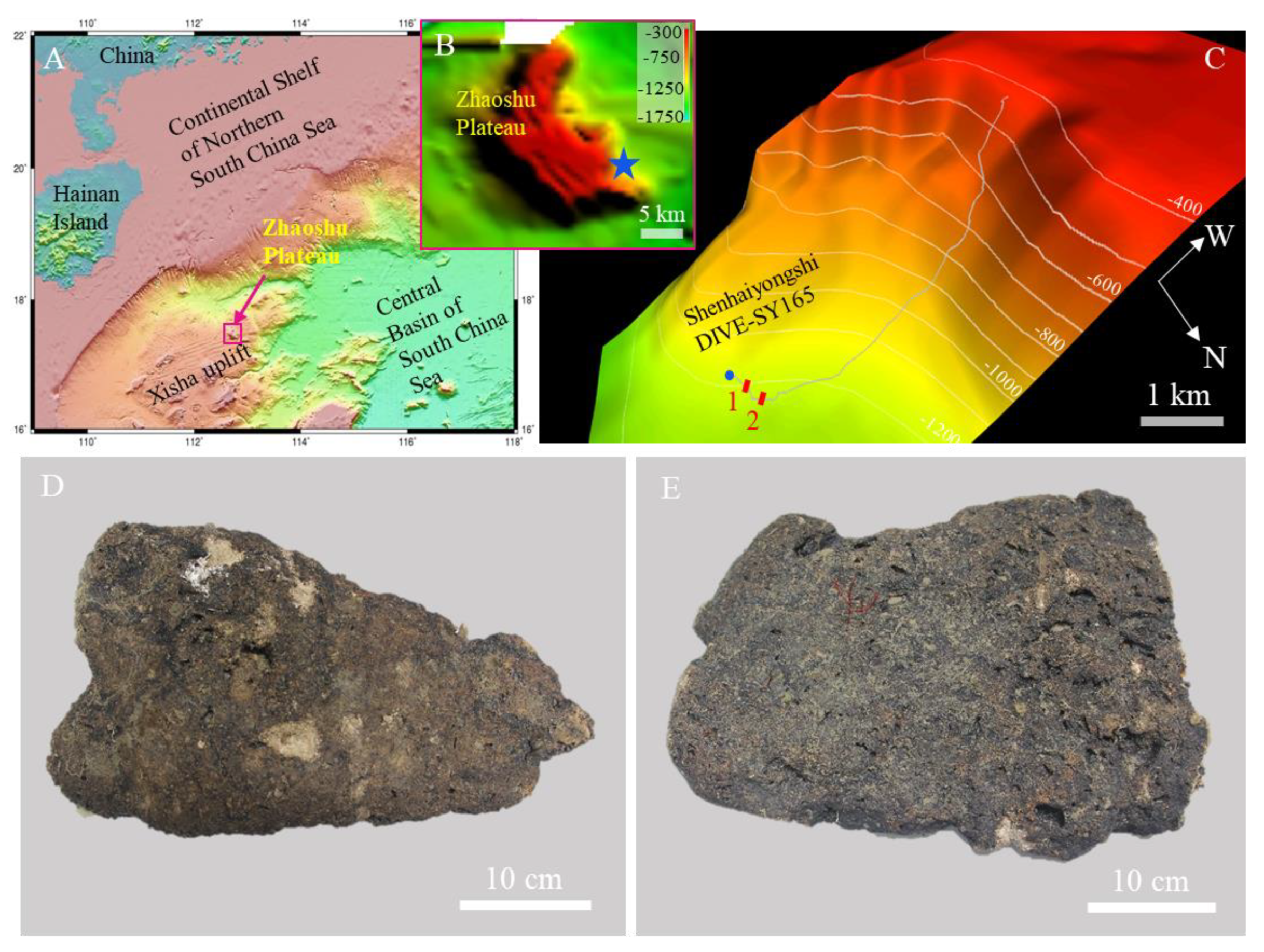
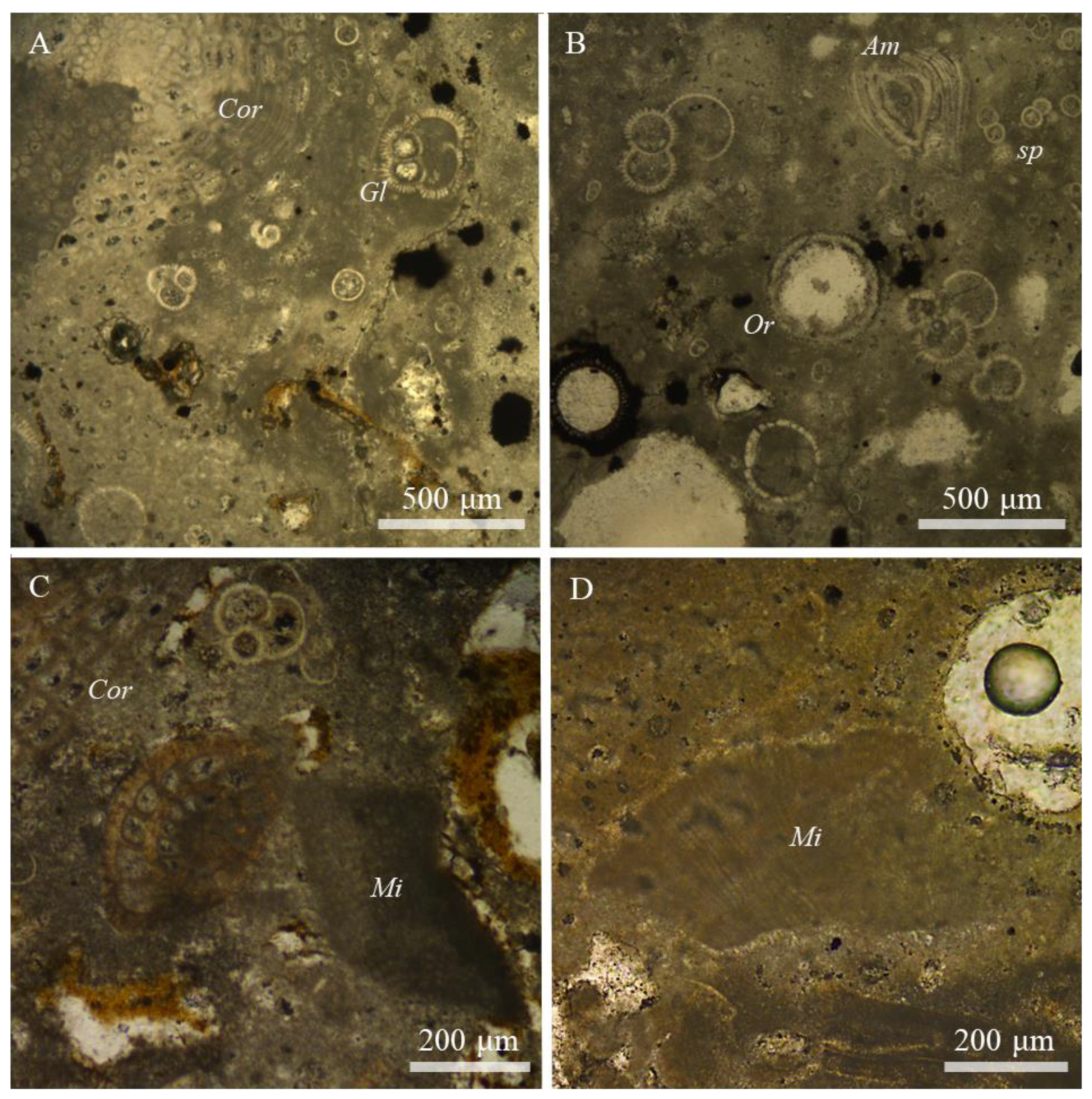
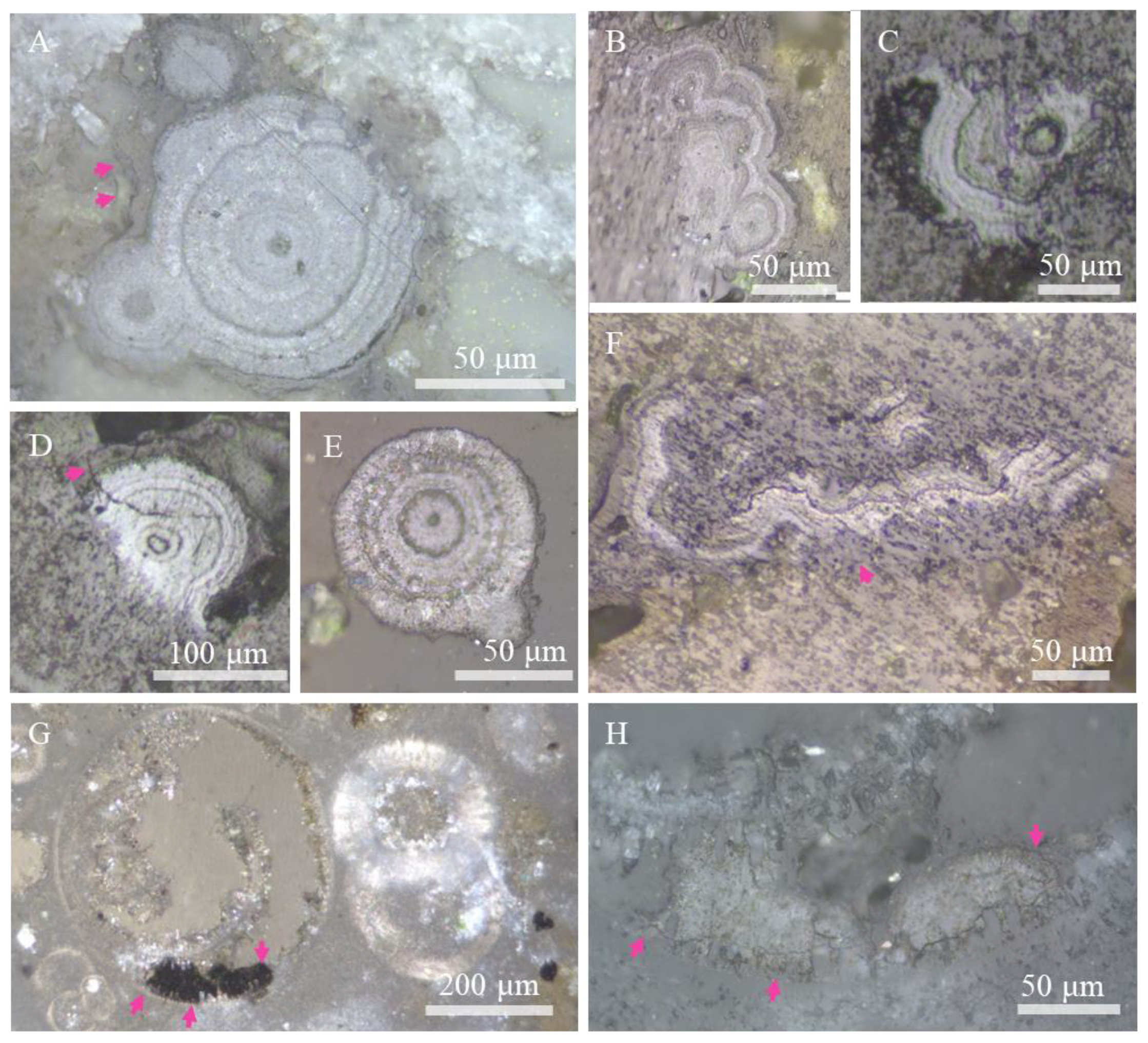
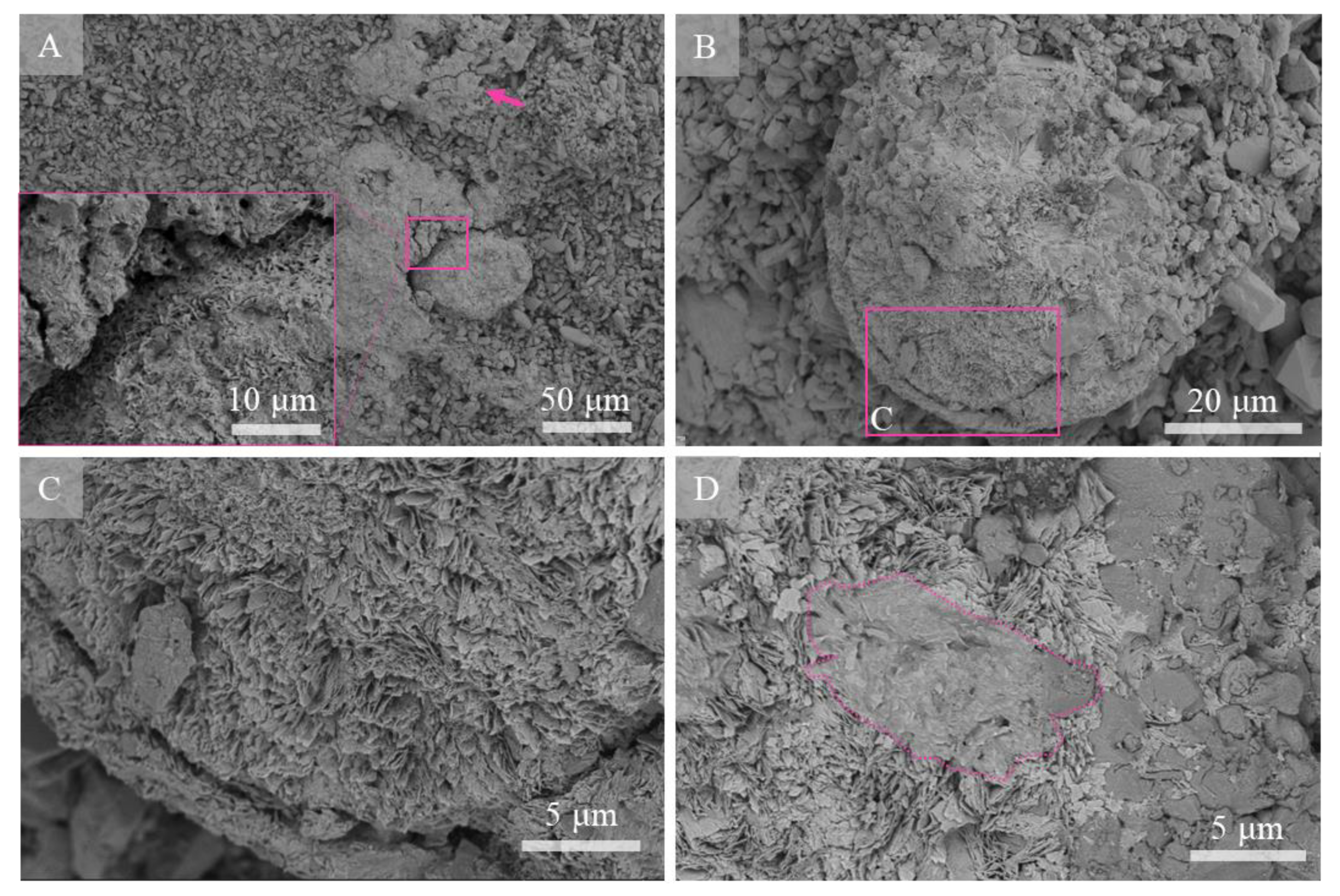
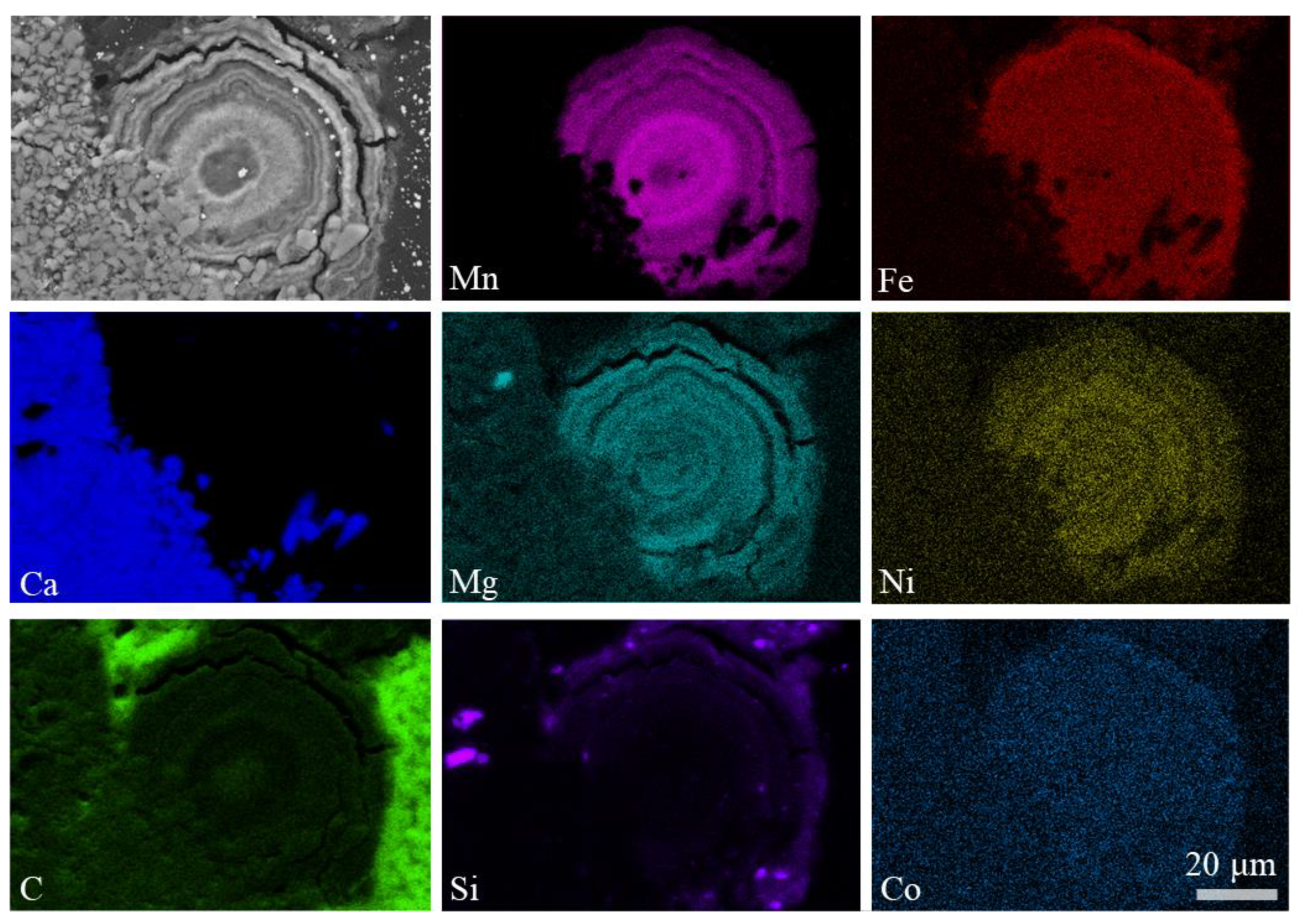



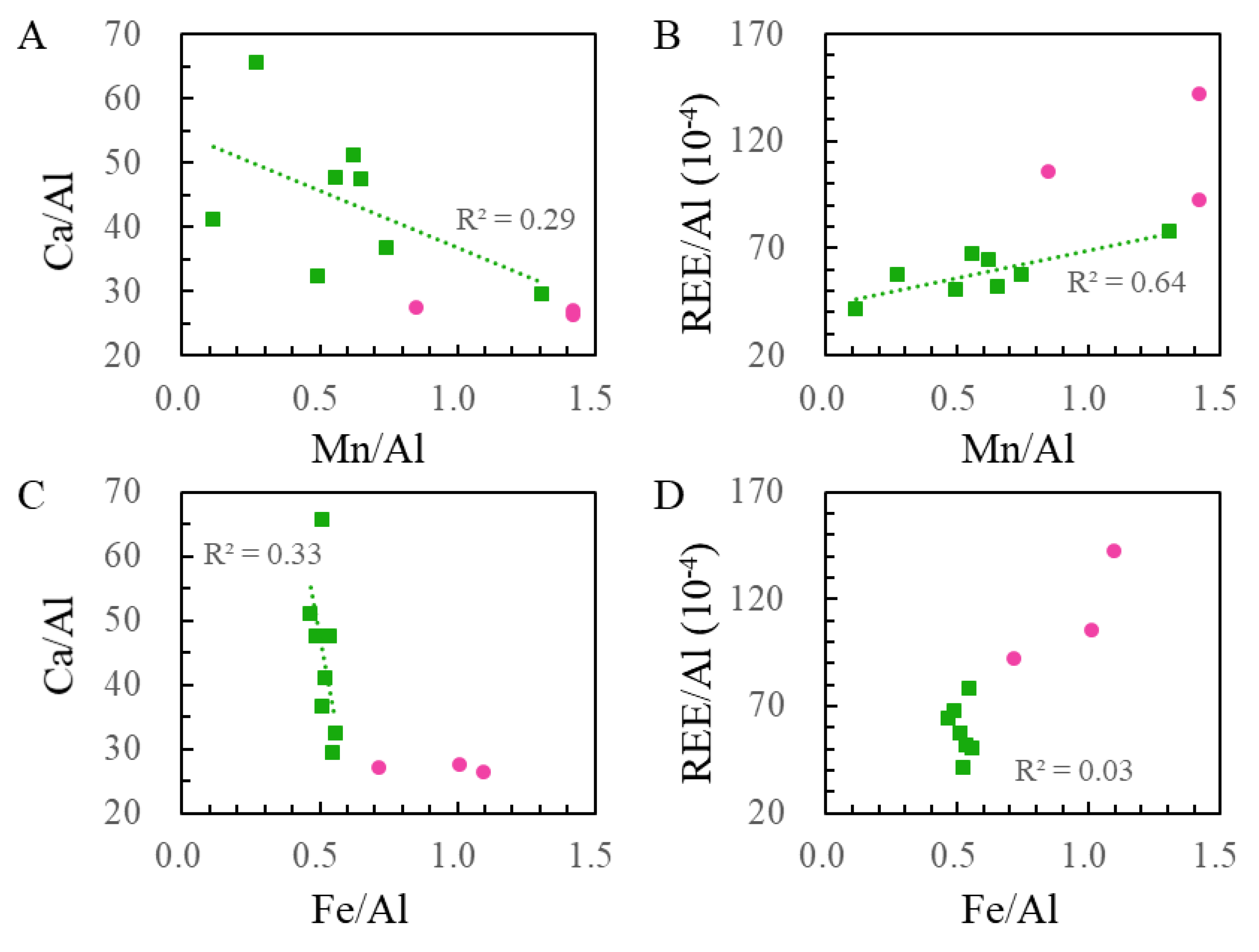
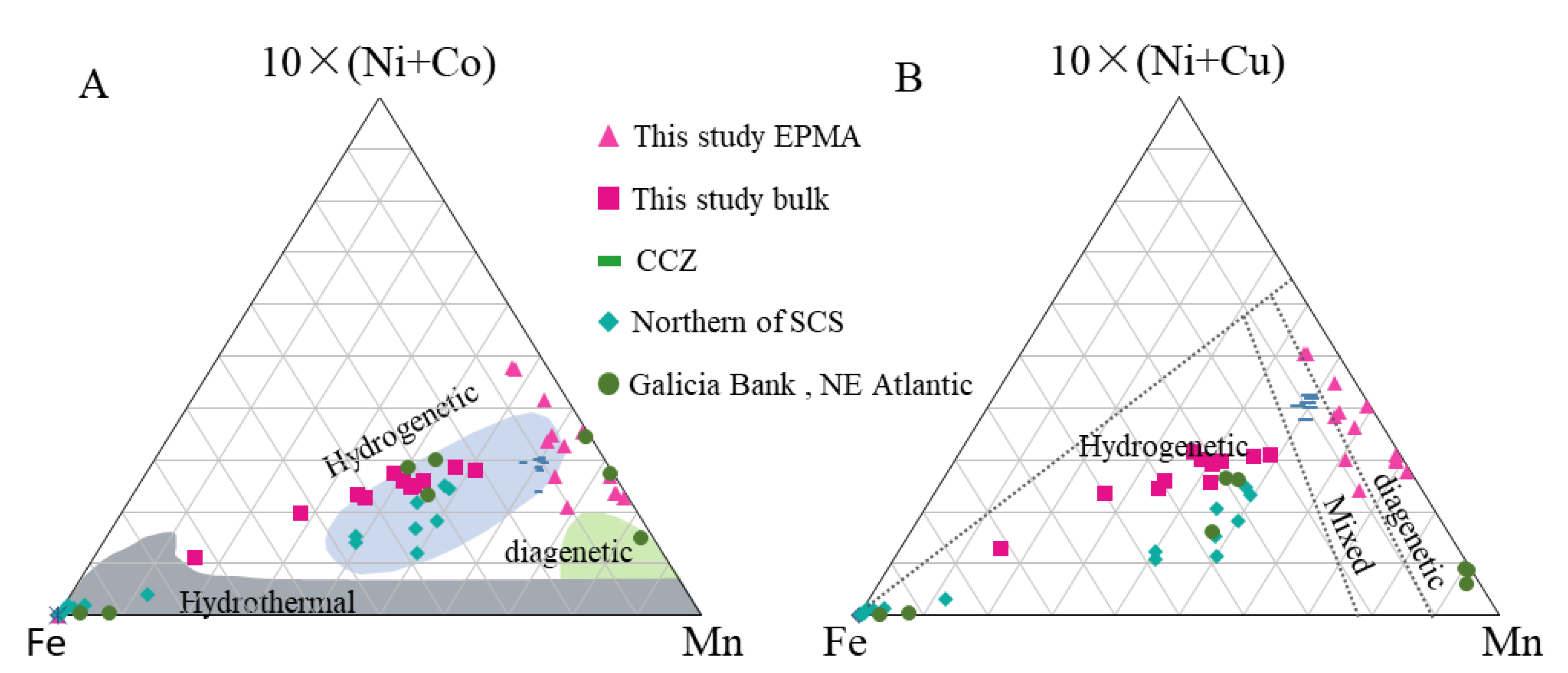
| Sample Name | Mn | Fe | Mn/Fe | Ca | Al | Si | Mg | Cr | Co | Ni | Cu | Zn |
|---|---|---|---|---|---|---|---|---|---|---|---|---|
| Mn encrust at surface (n = 4) | 34.62–40.51 37.85 | 4.27–6.15 4.97 | 6.59–9.17 7.76 | 0.69–0.99 0.78 | 1.31–3.98 2.62 | 0.73–1.06 0.87 | 2.80–6.74 4.61 | 0.03–0.19 0.11 | 0.06–0.12 0.08 | 1.17–3.93 2.53 | 0.30–0.61 0.43 | 0.15–0.25 0.20 |
| Nodule in the inner (n = 9) | 38.59–53.54 45.28 | 0.41–4.62 1.93 | 8.40–116.60 54.08 | 0.78–1.45 1.09 | 0.55–3.26 1.93 | 0.09–4.53 0.93 | 2.61–5.81 4.25 | 0.05–0.19 0.11 | 0.07–0.13 0.09 | 1.37–2.94 2.00 | 0.50–0.72 0.59 | 0.16–0.29 0.21 |
| Carbonate matrix (n = 4) | 0.004–0.103 0.04 | 0.003–0.08 0.03 | 0.28–3.86 1.45 | 37.98–39.17 38.67 | 0.004–0.15 0.05 | d.l.–0.21 0.14 | 0.63–0.85 0.72 | 0.01–0.03 0.02 | d.l.–0.02 0.004 | d.l.–0.04 0.02 | d.l.–0.01 0.009 | d.l. |
Publisher’s Note: MDPI stays neutral with regard to jurisdictional claims in published maps and institutional affiliations. |
© 2020 by the authors. Licensee MDPI, Basel, Switzerland. This article is an open access article distributed under the terms and conditions of the Creative Commons Attribution (CC BY) license (http://creativecommons.org/licenses/by/4.0/).
Share and Cite
Xu, H.; Peng, X.; Ta, K.; Song, T.; Du, M.; Li, J.; Chen, S.; Qu, Z. Structure and Composition of Micro-Manganese Nodules in Deep-Sea Carbonate from the Zhaoshu Plateau, North of the South China Sea. Minerals 2020, 10, 1016. https://doi.org/10.3390/min10111016
Xu H, Peng X, Ta K, Song T, Du M, Li J, Chen S, Qu Z. Structure and Composition of Micro-Manganese Nodules in Deep-Sea Carbonate from the Zhaoshu Plateau, North of the South China Sea. Minerals. 2020; 10(11):1016. https://doi.org/10.3390/min10111016
Chicago/Turabian StyleXu, Hengchao, Xiaotong Peng, Kaiwen Ta, Taoran Song, Mengran Du, Jiwei Li, Shun Chen, and Zhiguo Qu. 2020. "Structure and Composition of Micro-Manganese Nodules in Deep-Sea Carbonate from the Zhaoshu Plateau, North of the South China Sea" Minerals 10, no. 11: 1016. https://doi.org/10.3390/min10111016
APA StyleXu, H., Peng, X., Ta, K., Song, T., Du, M., Li, J., Chen, S., & Qu, Z. (2020). Structure and Composition of Micro-Manganese Nodules in Deep-Sea Carbonate from the Zhaoshu Plateau, North of the South China Sea. Minerals, 10(11), 1016. https://doi.org/10.3390/min10111016






